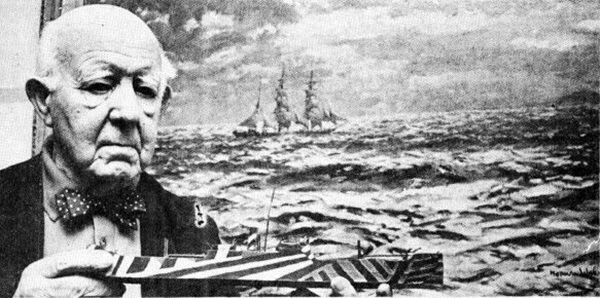
A Note for the Enquirers, Catechumens, the Afraid and Worried: Before reading on, and in light of comments we have seen at other sites about the dangers we are going through - Please note that the doctrine of Papal Infallibility and the nature of the Church are not touched, in their essence, by the present ambiguities and confusion surrounding Amoris Laetitia.
What is a Dazzle Ship?
During the First World War, both the Admiralty in Britain and the United States Navy adopted a scheme of ship camouflage known respectively as Dazzle (UK) and Razzle Dazzle (USA).
The intention of this type of camouflage was not so much to conceal, as to cause confusion regarding the size, range, speed and heading of a given vessel.
According to Dazzle's creator, the British marine artist Norman Wilkinson, this was meant to mislead the enemy about a ship's course; and thus cause him to take up a poor firing position.
Dazzle ships could thus be hard to pin down.
The testimony of a German U-Boat captain, archived by the Imperial War Museum, bears witness to the effectiveness of this technique. Having encountered a ship, whose stern was disguised as her bow, with dark green paint amidships to appear as a patch of water, the German captain mistook it for several ships moving in a different direction. He summarized this as the best example of naval camouflage that he had ever seen.
Clarity and PrecisionÂ
Unlike the hidden doctrines of Gnostics old and new, the Catholic Church has ever made her doctrines and moral teachings as clear and accessible as possible. This has been achieved through the use of precision in articulation, language and pastoral application. As St. Peter himself proclaimed: ''But sanctify the Lord Christ in your hearts, being ready always to satisfy every one that asketh you a reason of that hope which is in you'' (1 Peter 3:15).
This precision of articulation and explication found even greater impetus through the Church's Providential encounter and engagement with the thought-forms of the Greek and Latin worlds; what was good in these was taken up and purified.
Like a golden thread then, the progression of this wonderful clarity is in evidence throughout the many centuries of Catholic Church history. It flows everywhere from Christ through to the Apostles, the Didache and first Catechisms, on to the Early Fathers, the Christological Councils, St. Thomas Aquinas and the best of the Scholastics, forward through the saints of the Catholic Reformation, and on through the perspicuous teachings of Popes down to the modern era.Â
Not restricted to the spoken or written word, such clarity of exposition, accompanied by grace, has even given birth to rich and edifying expressions in art, architecture, customs, law, liturgy and music.
Obscurantists Old...

As early as the 2nd-Century, St. Irenaeus of Lyons was warning against the Gnosticism of those who would obscure Christ's message through complexity, secrecy and subterfuge. He wrote: ''Error never shows itself in its naked reality, in order not to be discovered. On the contrary, it dresses elegantly, so that the unwary may be led to believe that it is more truthful than truth itself.''
In stark contrast to the clear and accessible tradition of Catholic Truth stands, or rather lurks, the shrouded machinations of Gnosticism and its contemporary cohorts.
Pope St. Pius X and others were at pains to warn the Church of the manner in which Modernism, that sewer of all heresies as he described it, advances by way of obscurantism and subterfuge.
In our times, Modernism has really decayed into something even more stinking, in the corrosive anti-being poison of Post-Modernism.
Edward Schillebeeckx acknowledged that a technique employed by extreme liberals during the Second Vatican Council, was to allow ambiguities - or things stated in a ''diplomatic manner'' - to be inserted into the schema of the conciliar documents; these ambiguities could then be interpreted in a liberal manner after the Council.
I must add here that, although Schillebeeckx was among those extreme liberals at the Council, and that he knew of this subversive tactic, it now seems to me that I have done him an injustice in the past by claiming that he inserted some of those ambiguities.
It rather appears through further research, that, though he was aware of the tactic, he did not actually approve of it and indeed described it as unfair.
Still, that was merely because he wanted the extreme liberal position to be most clearly expressed in the actual documents to prevent ''conservatives'' from interpreting things their way later on!
In any case, it is claimed that the Pontiff wept when he discovered this type of ruse and realized that he had been deceived...
That there are ambiguities in the documents of the Second Vatican Council can be honestly denied by nobody. It is from the fissures of these ambiguities that the ''liberals'' have been able to emerge like shock troops and spend the last five decades dismantling the Church, at least in practical terms. If there were no ambiguities, there would be no need for a ''hermeneutic of continuity'' to begin with.
... And Obscurantists New

In the wake of Amoris Laetitia, we have witnessed a great variety of interpretations which, though not restricted to these categories by any means, include: this is not a Magisterial document at all; this is a Magisterial document, but of limited authority; this is a Magisterial document and you'd better tow the line buddy; this is a Magisterial document but there is no line in it to tow pal; this defeats the Kasper proposal; and this allows the Kasper proposal.
As various commentators take time to point out, there is not an actual change in the teaching of the Church to be found anywhere in the document. But then again, others demonstrate how there is...
The most terrifying thing here is to see how all of this confusion is being played out in real terms: with bishops in the Philippines and Germany, an archbishop in America, plus some priests in Italy, saying that they are going to start giving sacrilegious communions - well, they don't say it like that, but you catch their drift; an Archbishop in Spain giving the impression that he doesn't know what the heck to do; and men like Cardinal Raymond Burke saying that faithful Catholics should just carry on as usual. Although His Eminence is correct, the average parish priest and layman is then left feeling like a deck-chair attendant or a cellist on the Titanic!
One of the most remarkable things to emerge has been the attempt to blame the confusion on orthodox Catholics who point out that something is very wrong here.
Oh, and to blame those secular journalists! Yep, it must be their fault. Â
We hear that Patrick Archbold responded to this kind of thing with a witty riposte on the Remnant's Facebook page: ''Once again, stop telling me to interpret these documents in a Catholic way and start telling them to write them in a Catholic way.''
Indeed!
And yes, that about sums up the problem: Amoris Laetitia -Â in common with any number of ''off-the-cuff'' comments, airplane interviews, non-conversations with atheistic journalists like Eugenio Scalfari, private telephone conversations that we couldn't possibly comment on, meetings with mass-murdering Marxists, mass-murdering abortionists, population-control advocates, and homosexualists, and even unusual pro-Iscariot homilies in the age of Pope Francis - give off a very disturbing sense of, well, ambiguity.
The more cynical might even say plausible deniability.
An Example of What Seems to be a Disturbingly Sophisticated Use of Obscurantism in Amoris Laetitia

One of the most troubling things that we have read this week is an article at LifeSiteNews from the excellent Voice of the Family.
In spite of all the obvious machinations during Synods '14 and '15, the subversive attempt to get a limited acceptance of homosexual unions into the final reports of either synod was rejected.
During the ''process'' the Relatio post disceptationem and the Instrumentum Laboris, by means amply described in many places elsewhere (Ed Pentin is a good source to begin with), did include unfortunate passages which suggested that homosexual pairings, whilst not equal to marriage, did have some kind of legitimacy. By God's grace, and the courage of those orthodox prelates in the aula, these passages were rejected and did not make it into the Synod's Final Report.
However, and in something of a mockery of the entire synodal process, to say nothing of natural and divine law, such an approach has subtly found its way back into the final text of Amoris Laetitia!
Many orthodox Catholics, perhaps sighing that we've dodged a bullet, have been lauding AL52 in strong terms as a defence of Catholic teaching on marriage.
It reads: ''We need to acknowledge the great variety of family situations that can offer a certain stability, but de facto or same-sex unions, may not simply be equated with marriage.''
Now, at least at first glance, this does seem to be a clear, if somewhat weak, defence of the Church's traditional teaching.
Hoorah! After the last two Red Octobers, we could all do with a glass of something sparkly!
However, we'd better keep the cork for another day...
With their decades of collective experience of lobbying at the UN, the EU and at the level of national governments, Voice of the Family are very well aware that such phrases are often inserted into documents so they can later be exploited to pursue a radical ideological agenda.
Here is their astute and logical critique of AL52:
''This implies:
1. That ''same-sex unions'' are one ''of the great variety of family situations'';
2. That ''same-sex unions'' offer a ''certain stability'' and;
3. That ''same-sex unions'' can be equated with marriage on some level, if not ''simply.''
Furthermore the paragraph states that ''only the exclusive and indissoluble union between a man and a woman has a plenary role to play in society as a stable committment that bears fruit in new life. To state that only marriage has a ''plenary role'' necessarily means that other forms of union do have some role to play in society.''
No champagne here then. Bah!
Barque of Peter or Post-Modern Dazzle Ship?

Not a few commentators are trying to suggest that this type of critique reads too much into the document (!) and that such examples must be somehow accidental.
To such a comment one really does feel like politely asking the person to draw back their curtains and tell us just how many moons there are on their planet...
In light of all that we have seen in the last three years, most especially in the manner in which Synods '14 and '15 were, shall we say, handled - oh those dark Octobers! - this approach must surely be naive at best. At worst, it could be seen as wilful blindness.
Whilst we can perhaps not attribute motive, there certainly does appear to be a very sophisticated employment of obscurantism at work in all of this.
Is it sophisticated obscurantism at the root of all this confusion?
In a truly post-modern sense - and in league with the kind of thinking typified by the Talmudists we mentioned earlier this week - language itself seems to be viewed as having no reality in being.
As such it can be used as a cloak, sounding orthodox to those who want it to; and unorthodox to those who desire that.
How like the use of Marxist dialectic this all sounds. And how unlike the two-millenia-old Catholic way of insisiting on the clarity of every formula. Yes, as the Fathers at Nicaea, Constantinople and Chalcedon recognized: sometimes the whole world really does hang on a single dipthong.Â

Are we ''Leaving Safe Harbours'' Once Again?
If such a sophisticated obscurantist ruse were being employed, especially when it relates to reverence for the Blessed Sacrament, to the very nature of the Church and to the salvation of millions of souls, this would constitute the very definition of the diabolical.
As we read in Matthew 5:37: ''But let your speech be yea, yea: no, no: and that which is over and above these, is of evil.''
If we are right, and we pray to God that we are not, then, this would represent the attempt to deconstruct the very Barque of Peter; and to reconstruct it, in the very deepest sense possible, as a Post-Modern Dazzle Ship.
If one can no longer recognize the ship, or its edges, it could be difficult to stay on board in a storm. Indeed, new shipmates might find it difficult to recognize, much less board, such a peculiar vessel.
In the words of the aforementioned U-Boat captain: ''This was the best camouflage I had ever seen.''
Hmmm... It seems like we're all being painted into a corner...
May the Most Holy Trinity Protect and Guide Us in All Truth.
Keep the Faith!Â



